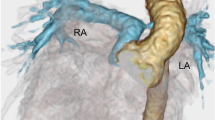Summary
A 9-year-old patient who had had a syncope was found to have atrial flutter in a resting electrocardiogram (ECG). Brief phases of sinus arrest had previously occurred after drug conversion to sinus rhythm. Structural heart disease was excluded by cardiac catheterization and angiography. Electrophysiologic study revealed a sick sinus syndrome, associated with diffuse impairment of the conduction system (supra-, infra-, and intrahisian block). Epimyocardial and an endocardial pacemaker implantation failed because of high stimulation threshold, after 3 years and 2 weeks, respectively. At the third implantation a steroid-eluting endocardial pacing lead was used and satisfactory pacing was still present 2 years later.
Similar content being viewed by others
References
Alboni P, Malacarne C, Baggioni GF, Antonioli GE (1977) “Sick sinus syndrome” idiopatica con turbe della conduzione A-V ed intraventricolare in un bambino. Primo rapporto in eta' pediatrica.G Ital Cardiol 7:514–520
Beder SD, Gillette PC, Garson A, Jr, Porter CJ, McNamara DG (1983) Symptomatic sick sinus syndrome in children and adolescents as the only manifestation of cardiac abnormality or associated with unoperated congenital heart disease.Am J Cardiol 51:1133–1136
Bharati S, Nordenberg A, Bauernfiend R, Varghese JP, Carvalho AG, Rosen K, Lev M (1980) The anatomic substrate for the sick sinus syndrome in adolescence.Am J Cardiol 46:163–172
Ennker J, Stegmann Th, Luhmer I, Oelert H (1985) Risks and benefits of cardiac pacing in children.Int J Cardiol 8:125–134
Gillette PC, Shannon C, Blair H, Garson A, Jr, Porter CJ, McNamara DG (1983) Transvenous pacing in pediatric patients.Am Heart J 105:843–847
James TN (1970) Cardiac conduction system: Fetal and postnatal development.Am J Cardiol 25:213–226
James TN, Frogatt P, Marshall TK (1967) Sudden death in young athletes.Ann Intern Med 67:1013–1021
King DH, Gillette PC, Shannon C, Cuddy TE (1983) Steroid eluting endocardial pacing lead for treatment of exit block.Am Heart H 106:1438–1440
Kugler JD, Danford DA (1989) Pacemakers in children: An update.Am Heart J 117:665–679
Mond H, Stokes K, Helland J, Grigg L, Kertes P, Pate B, Hunt D (1988) The porous titanium steroid eluting electrode: A double blind study assessing the stimulation threshold effects of steroid.PACE 11:214–219
Simon AB, Dick M II, Stern AM, Behrendt DM, Sloan H (1982) Ventricular pacing in children.PACE 5:836–844
Yabek SM, Swensson RE, Jarmakani JM (1977) Electrocardiographic recognition of sinus node dysfunction in children and young adults.Circulation 56:235–239
Author information
Authors and Affiliations
Rights and permissions
About this article
Cite this article
Capucci, A., Boriani, G., Galli, R. et al. Sick sinus syndrome and diffuse impairment of the conduction system in a child: Successful pacing with a steroid eluting endocardial pacing lead. Pediatr Cardiol 13, 44–47 (1992). https://doi.org/10.1007/BF00788230
Issue Date:
DOI: https://doi.org/10.1007/BF00788230




